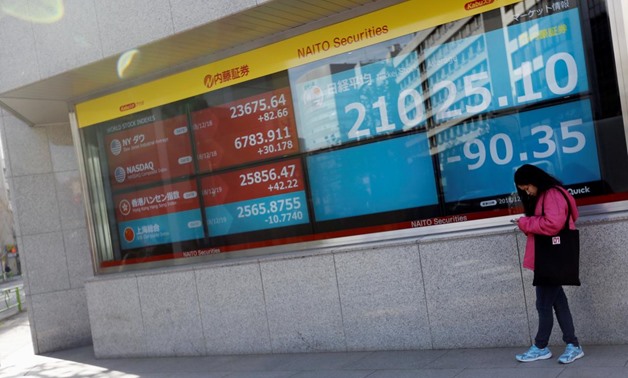
A woman stands in front of a screen displaying Japan's Nikkei share average, U.S. and other countries' stock market indicators outside a brokerage in Tokyo, Japan December 19, 2018. REUTERS/Issei Kato
TOKYO (Reuters) - Asian shares slid on Thursday after the U.S. Federal Reserve raised rates, as expected, and kept most of its guidance for additional hikes over the next two years, dashing investor hopes for a more dovish policy outlook.
MSCI’s broadest index of Asia-Pacific shares outside Japan dropped 1.1 percent, with Australian shares also declining 1.3 percent to a two-year closing low.
Markets across the region are nearing gloomy milestones, with Japan’s Topix and South Korea’s KOSPI falling into a bear market, which means they are down more than 20 percent from their recent highs, to join Shanghai and Hong Kong’s Hang Seng.
Financial spread-betters expect London’s FTSE Frankfurt’s DAX and Paris’s CAC to fall between 1.2 and 1.4 percent when they open.
Japan’s Nikkei shed 2.8 percent to close at its lowest since September 2017.
China’s benchmark Shanghai Composite and the blue-chip CSI 300 fell 0.5 percent and 0.8 percent, respectively, while the Hang Seng was off 1.1 percent.
In New York, U.S. S&P 500 Index lost 1.54 percent to hit its lowest level since September 2017. U.S. stocks are on pace for their biggest December decline since 1931, the depths of the Great Depression.
“I think the Fed may be underestimating other factors at play,” said Bob Baur, chief global economist at Principal Global Investors in Des Moines, Iowa in the Unites States.
“Trade has been making headlines, but I think a gradual tightening of monetary policy has been the driving force behind recent market volatility. With corporate borrowing and spending still high, and the Fed continuing to reduce its balance sheet, I’d expect volatility to remain if this tightening continues,” he said.
The Fed raised key overnight lending rate rates by 0.25 percent point as expected to a range of 2.25 percent to 2.50 percent.
It said “some further” rate hikes would be necessary in the year ahead, with its policymakers projecting two rate hikes on average next year instead of three they saw back in September, a change that was also largely in line with expectations.
But the slight revision was not enough to ease market fears over a further U.S. economic slowdown on the back of trade tensions, a waning boost from tax cuts and tightening monetary conditions for companies.
U.S. junk bonds sold off sharply, with their ETFs falling 0.9 percent, the biggest decline since March 1.
As investors flocked to the safety of government bonds, the 10-year U.S. Treasuries yield fell to as low as 2.748 percent, a level last seen in early April.
A rise in short-term interest rates and a fall in the long-dated yield rekindled worries of an inversion in the yield curve, where shorter-debt yields become higher than longer-term ones.
Historically, an inversion between short-yields, such as three-month and two-year yields, and 10-year yields has been seen as a fairly reliable indicator of a recession down the road.
“We expect additional rate hikes will invert the three-months to 10-year yield curve which is a reliable signal for a bear market for stocks and a coming recession for both the U.S. and the rest of the world,” said Jeffrey Kleintop, Chief Investment Strategist at Charles Schwab in Boston.
“So, seriously something to keep a close eye on. We do expect a very difficult year for investors.”
The two-year U.S. yield stood at 2.654 percent, just 0.103 percentage point less than the 10-year yield.
As one 25 basis point rate hike would likely invert the yield curve, many market players are sceptical whether the Fed can raise rates at all next year.
Fed funds futures are now pricing in only about a 50 percent chance of one rate hike.
The dollar initially gained as the Fed was seen as more hawkish but it lost steam against other safe-haven currencies, such as the yen.
The greenback slipped 0.6 percent to its 7-1/2-week low of 111.865, while the euro also gained a tad to $1.1397.
The Chinese yuan weakened after China’s central bank introduced a targeted lending measure on Thursday to support growth in a slowing economy.
The onshore yuan was trading at 6.902 per dollar, 0.1 percent weaker on the day, having earlier weakened to 6.915 per dollar.
On Thursday, Japan kept its policy settings unchanged, as expected.
Later in the day, UK and Sweden will make policy announcements. Both are expected to keep their policies on hold, though the Swedish central bank’s decision is seen as a close call, with some analysts expecting a rate hike.
Oil prices fell on Thursday to erase most of their gains from the day before, resuming declines seen earlier in the week amid worries about oversupply and the outlook for the global economy.
The front-month U.S. crude contract dropped 2.1 percent to $47.18 per barrel, while international benchmark Brent crude futures were down 1.5 percent at $56.39 per barrel.


Comments
Leave a Comment